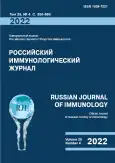Effect of cucurbiturils on cytokine production by peripheral blood mononuclear cells of healthy donors
- Authors: Aktanova A.A.1, Kovalenko E.A.1,2, Pashkina E.A.1
-
Affiliations:
- Research Institute of Fundamental and Clinical Immunology
- A. Nikolaev Institute of Inorganic Chemistry, Siberian Branch, Russian Academy of Sciences
- Issue: Vol 25, No 4 (2022)
- Pages: 369-374
- Section: SHORT COMMUNICATIONS
- URL: https://journals.rcsi.science/1028-7221/article/view/120050
- DOI: https://doi.org/10.46235/1028-7221-1183-EOC
- ID: 120050
Cite item
Full Text
Abstract
Many drug delivery systems are currently under study, e.g., nanosized cavitands cucurbiturils, which, due to the presence of a cavity, can incorporate drug molecules. Since the immune system is quite sensitive to influence of nanomaterials and other cell-damaging factors, it is necessary to study immunosafety of the new delivery systems, i.e., immunotoxicity and immunomodulatory properties. The aim of this study was to investigate the effect of nanosized cucurbituril cavitands on the cytokine-producing ability of peripheral blood mononuclear cells in apparently healthy donors.
Blood mononuclear cells (106/mL) were cultured in the presence of cucurbiturils at the following concentrations: 0.3 mM cucurbit[6]uril, 0.3 mM cucurbit[7]uril, and 0.01 mM cucurbit[8]uril for 72 h, under additional stimulation with aCD3 antibodies (1 µg/mL), or without it. The level of cytokines in the supernatants was determined using enzyme immunoassay.
It was shown that cucurbit[6]uril increased the level of spontaneous IL-4 production by 1.5 times (p < 0.01) compared with the control. In the case of stimulated cytokine production, we found that cucurbit[6]uril reduced the level of IL-6, and also shows a tendency (p = 0.09) towards an increase in the IL-4 level. When cells were cultured with cucurbit[7]uril, we gave revealed a trend for increased production of pro-inflammatory TNF. It was also found that cucurbit[7]uril is able to suppress the production of IL-10 in aCD3-stimulated cell culture by 1.5 times. Cucurbit[8]uril was shown to inhibit production of cytokines in non-stimulated cell cultures. A significant decrease in the level of IFNγ and IL-10 was revealed as compared with the production of these cytokines in control cultures. When assessing the effect of cucurbit[8]uril on the IFNγ production upon stimulation with aCD3 antibodies, no significant differences were found, but there is also a trend for a decreased concentration of this cytokine agains control levels.
Cucurbiturils can influence both spontaneous and stimulated production of cytokines by the blood mononuclear cells. The effect on cytokine-producing ability of the cells depends on the tested homologue compound.
Keywords
Full Text
##article.viewOnOriginalSite##About the authors
A. A. Aktanova
Research Institute of Fundamental and Clinical Immunology
Author for correspondence.
Email: aktanova_al@mail.ru
Postgraduate Student, Laboratory of Clinical Immunopathology
Russian Federation, NovosibirskE. A. Kovalenko
Research Institute of Fundamental and Clinical Immunology; A. Nikolaev Institute of Inorganic Chemistry, Siberian Branch, Russian Academy of Sciences
Email: aktanova_al@mail.ru
PhD (Сhemistry), Research Associate
Russian Federation, Novosibirsk; NovosibirskE. A. Pashkina
Research Institute of Fundamental and Clinical Immunology
Email: aktanova_al@mail.ru
PhD (Biology), Senior Research Associate, Laboratory of Clinical Immunopathology
Russian Federation, NovosibirskReferences
- Aktanova A., Abramova T., Pashkina E., Boeva O., Grishina L., Kovalenko E., Kozlov V. Assessment of the biocompatibility of cucurbiturils in blood cells. J. Nanomaterials, 2021, Vol. 11, no. 6, 1356. doi: 10.3390/nano11061356.
- Chen H., Chan J.Y.W., Yang X., Wyman I.W., Macartney D.H., Bardelang D., Lee S.M.Y., Wang R. Developmental and organspecific toxicity of cucurbit[7]uril: In vivo study on zebrafish models. J. RSC Adv., 2015, Vol. 5, pp. 30067-30074.
- Czarnomysy R., Bielawska A., Bielawski K. Effect of 2nd and 3rd generation PAMAM dendrimers on proliferation, differentiation, and pro-inflammatory cytokines in human keratinocytes and fibroblasts. Int. J. Nanomedicine, 2019, Vol. 14, pp. 7123-7139.
- Das D., Assaf K.I., Nau W.M. Applications of cucurbiturils in medicinal chemistry and chemical biology. J. Front. Chem, 2019, Vol. 7, pp. 619-631.
- Hettiarachchi G., Nguyen D., Wu J., Lucas D., Ma D., Isaacs L., Briken V. Toxicology and drug delivery by cucurbit[n]uril type molecular containers. PLoS One, 2010, Vol. 5, no. 5, e10514. doi: 10.1371/journal.pone.0010514.
- Jeon Y.J., Kim S.Y., Ko Y.H., Sakamoto S., Yamaguchi K., Kim K. Novel molecular drug carrier: Encapsulation of oxaliplatin in cucurbit[7]uril and its effects on stability and reactivity of the drug. J. Org. Biomol. Chem, 2005, Vol. 3, pp. 2122-2125.
- Mazdaei M., Asare-Addo K. A mini-review of nanocarriers in drug delivery systems. Br. J. Pharm., 2022, Vol. 7, iss. 1. doi: 10.5920/bjpharm.780.
- Oun R., Floriano R.S., Isaacs L., Rowana E.G., Wheate N.J. The ex vivo neurotoxic, myotoxic and cardiotoxic activity of cucurbiturilbased macrocyclic drug delivery vehicles. J. Toxicol. Res., 2014, Vol. 3, pp. 447-455.
- Pashkina E., Aktanova A., Blinova E., Mirzaeva I., Kovalenko E., Knauer N., Ermakov A., Kozlov V. Evaluation of the immunosafety of cucurbit[n]uril on peripheral blood mononuclear cells in vitro. Molecules, 2020, Vol. 25, no. 15, 3388. doi: 10.3390/molecules25153388.
- Uzunova V.D., Cullinane C., Brix K., Nau W.M., Day A.I. Toxicity of cucurbit[7]uril and cucurbit[8]uril: An exploratory in vitro and in vivo study. J. Org. Biomol. Chem., 2010, Vol. 8, pp. 2037-2042.
Supplementary files







